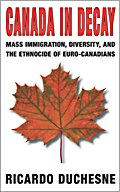What We Believe
Immigration Watch Canada believes that Canada should do the following :
(1) DRAMATICALLY REDUCE IMMIGRATION LEVELS
We believe in major reductions to Canada's present immigration levels. As we noted in the section “Who We Are”, Canada currently accepts close to 260,000 immigrants per year. But there is pressure to raise those levels to 1% of Canada's population. This would amount to an annual immigration level of 320,000+ which would increase in perpetuity. We believe that number will cause economic, environmental and cultural mayhem and that immigration levels have to return to Canada's traditional tap-on, tap-off policy with a goal of population stabilization.
To compensate for the excessive and unjustified immigration levels since 1990, we believe that immigration should be reduced to an intake in the range of 50,000 per year. We believe this reduction should continue until there is a clear and well-documented case for either increasing it or decreasing it further. In other words, Immigration Watch Canada believes in dramatic reduction of immigration levels, but we do not advocate abolition of immigration.
(2) BE HUMANE WITH GENUINE REFUGEES, BUT DO NOT PUT UP WITH FRAUD
We believe in retaining some parts of Canada's present refugee system. At present, Canada accepts around 10,000 refugees who are selected abroad from refugee camps. We believe in a wise continuation of this policy. More importantly, we believe in generous increases in Canadian government assistance to genuine refugees in refugee camps around the world. Currently, Canada throws away literally billions of dollars in catering to the needs of asylum seekers who claim to be refugees. However, Canada gives only a pittance to genuine refugees.
Most importantly, we agree with the United Nations policy of protecting refugees until they can be resettled in their own countries. We advocate that the Canadian government do all that it can internationally to further this U.N. policy. Unlike Canada's immigration industry, we do not believe that the world should be brought to Canada.
We disagree with most of Canada's current asylum-seeker policies. We believe that they have been grossly abused by people who are, in fact, economic immigrants and that Citizenship and Immigration has done little to correct the abuse of the system. In effect, Citizenship and Immigration, and the federal government in general, have allowed the asylum-seeker policy to become a second immigration door into Canada.
Since 1989, well over 700,000 asylum-seekers have used this door. According to James Bissett, a former Executive-Director of Canada's Immigration Service for 5 years, the vast majority of people who have claimed asylum are not genuine refugees fleeing persecution. These fraudulent refugee claimants have virtually paralyzed the quasi-legal and legal systems made available to them. The system has become so overloaded that the federal government has been forced to grant them amnesties from time to time.
Citizenship and Immigration euphemistically refers to these amnesties as “Administrative Reviews”. This means that our federal government has forgiven cheaters. Literally hundreds of thousands of people who have entered through the “Family Class” category have been sponsored by these cheaters. In these and other cases where these fraudulent claimants have been granted landed status, the practice of granting amnesty or “Administrative Reviews” has encouraged more to abuse the system. This abuse has to end.
(3) RECOGNIZE LIMITS TO THE NUMBER OF WORKERS WE CAN ABSORB
We believe (based on the federal government's own economic research and Canada's own previous tradition of adhering to labour absorptive capacity) that there are limits to the number of workers of any type that a country needs or can absorb. Present immigration levels in Canada pay no attention to the principle of economic absorptive capacity, ignore a real unemployment level of over 2 million and seem to assume that Canada can admit a virtually limitless number of new workers.
As a result, immigration levels have far exceeded Canada's economic absorptive capacity. In effect, they are an historical anomaly. Adhering to labour absorptive capacity in the past has meant that when Canada needed workers from outside its borders, it looked for those workers. When it did not need them, it did not look for them.
Two aberrations have resulted from Canada's present immigration levels:
(a) Immigrants have found that, contrary to what they have been told by Citizenship and Immigration Canada, they cannot find work in the areas for which they have been trained. Consequently, many immigrants are unemployed and relying on social assistance or they are underemployed.
(b) More significantly, Canadian-born have found that they are competing for employment with recently-arrived immigrants. In addition, they are the victims of their own government's Employment Equity programmes (known in the United States as affirmative action programmes). Employment Equity measures (really Employment “Inequity” measures) deny them equality in job applications, and favour immigrants whose job skills, in most cases, were and are surplus to the labour absorptive capacity of Canada's economy.
In effect, Employment Equity measures amount to institutionalized discrimination by Canadian employers (both public and private) against Canadian-born. As Dr. Martin Loney has pointed out in his comprehensive study of this issue, Employment Equity measures are not based on evidence, but on ideology. We believe this entire very expensive and unjust programme has to be abolished.
(4) RECOGNIZE ENVIRONMENTAL LIMITS TO THE NUMBER OF IMMIGRANTS WE CAN TAKE
All Canadians should note that in 1976, The Science Council of Canada examined the issues of Canada's resources and its future population. It stated bluntly that Canada had to discard two myths: One is that it has an infinite supply of resources. The second is that it could have a virtually open-door immigration policy. It stated that a large geographical space does not mean an ability to take huge numbers of people. Canada's hostile climate meant that its people had to consume larger amounts of resources than people in many other countries. Consequently, Canada had to conserve the resources it had, to restrict immigration, and to stabilize its population, roughly around the 35 million mark.
Studies at UBC in 1997 and by Ontario's Environment Commissioner recently have issued similar warnings. Ontario's Environment Commissioner has stated that Southern Ontario does not have enough water for the large population increase that our blind federal government plans to dump into southern Ontario.
Yet many Canadian politicians, pundits and some recent immigrants continue to think that Canada can accommodate literally hundreds of millions of people.
If Canada continues its policy of taking in around 250,000 immigrants per year, this would mean adding a million people to Canada's population every four years through immigration alone. When Canada's natural increase and the children of immigrants are added, many more than 1 million people would be added to Canada's population every four years.)
At a time when Canada professes to believe in adhering to its committments to the Kyoto Accord to reduce Greenhouse gas emissions below its 1990 levels, Canada has added almost 6 million new people to its population since 1990. Immigration has been the single largest factor in this increase. Since most scientists argue in favour of world population stabilization and reduction, it makes no scientific or environmental sense to continue to increase Canada's population.
Most of Canada's immigants go to three metropolitan areas. The flow of immigrants into those areas has resulted in dramatic population increases there and significant environmental damage. For example, in the Greater Vancouver area, it took about 130 years (roughly 1856 to 1988) to reach a population level of 1.4 million. It took just another 12 years to reach 2.1 million.
Toronto (even more so than Vancouver) and Montreal have had similar experiences. (Even if Canada's Department of Citizenship and Immigration insisted that new immigrants go to smaller population centres, what smaller population centres really need more people?
Canadians should note that it is a fact that about 40% of Canada's area is Arctic and even more is sub-Arctic. Would the “vast, empty spaces” lobby agree that these new people should go to Baffin Island and other parts of Canada's Arctic (North of 60)? Would small-town Canada south of 60 want to be flooded by immigrants?
The inundation of urban centres like Greater Vancouver by people (largely immigrants) has resulted in large-scale traffic congestion; increases in air pollution; disappearance of greenspace; increased pressure on remaining greenspace and farmland to be converted to housing; densification and infilling of many neighbourhoods; an erasing of Vancouver's building heritage; increased demands on the servicing capacities of existing infrastructure; increased demands to replace existing infrastructure (resulting in added tax costs to the resident population which, ironically, never needed the population inflow that the federal government has imposed on it).
The large urban areas do not have the environmental capacity to absorb present high immigration levels. The small areas of Canada (with their high unemployment levels) do not have the economic capacity to absorb the high numbers.
(5) RECOGNIZE THE CULTURAL LIMITS TO THE NUMBER OF IMMIGRANTS WE CAN TAKE
We believe there are cultural limits to the number of people any country can absorb. Canada now accepts more immigrants per capita than any other developed country. The inflow of several million immigrants/refugees into Canada's three urban areas since 1990 has had a dramatic effect on the Canadian-born as well as earlier immigrants in those areas. In a number of places, long-term residents have suddenly become a minority in their communities.
Canada's diversity promoters like to tell us to celebrate diversity, but long-term residents of Canada believe they are being told to celebrate their marginalization.
Canada's multiculturalists have welcomed the unprecedented rise in immigration levels and simultaneously implied that Canada was a cultural wasteland before “The Flood” began around 1989. Most Canadians, particularly those in Canada's major urban areas, feel that they are being overwhelmed by the high numbers of recent immigrants. Canada is supposed to be a country with control over its borders, but it has been turned into a colony of countries wishing to export people. A goal of a significant number of these people is to have their groups outnumber the long-term population of Canada. All of this has been accomplished through the complicity of Canada's immigration industry and Canada's federal government.
The two landmark federal studies of the immigration issue (“Charting Canada's Future” and “New Faces In The Crowd”) both cautioned about the social consequences of large and sudden demographic change. Most urban Canadians believe that sanity has to be restored to Canada's present immigration policies. In other words, Canada's immigration policies have to be taken out of the hands of Canada's immigration industry and a number of federal politicians and placed under the rightful, democratic control of the people of Canada. Canadians have to take back their country.




